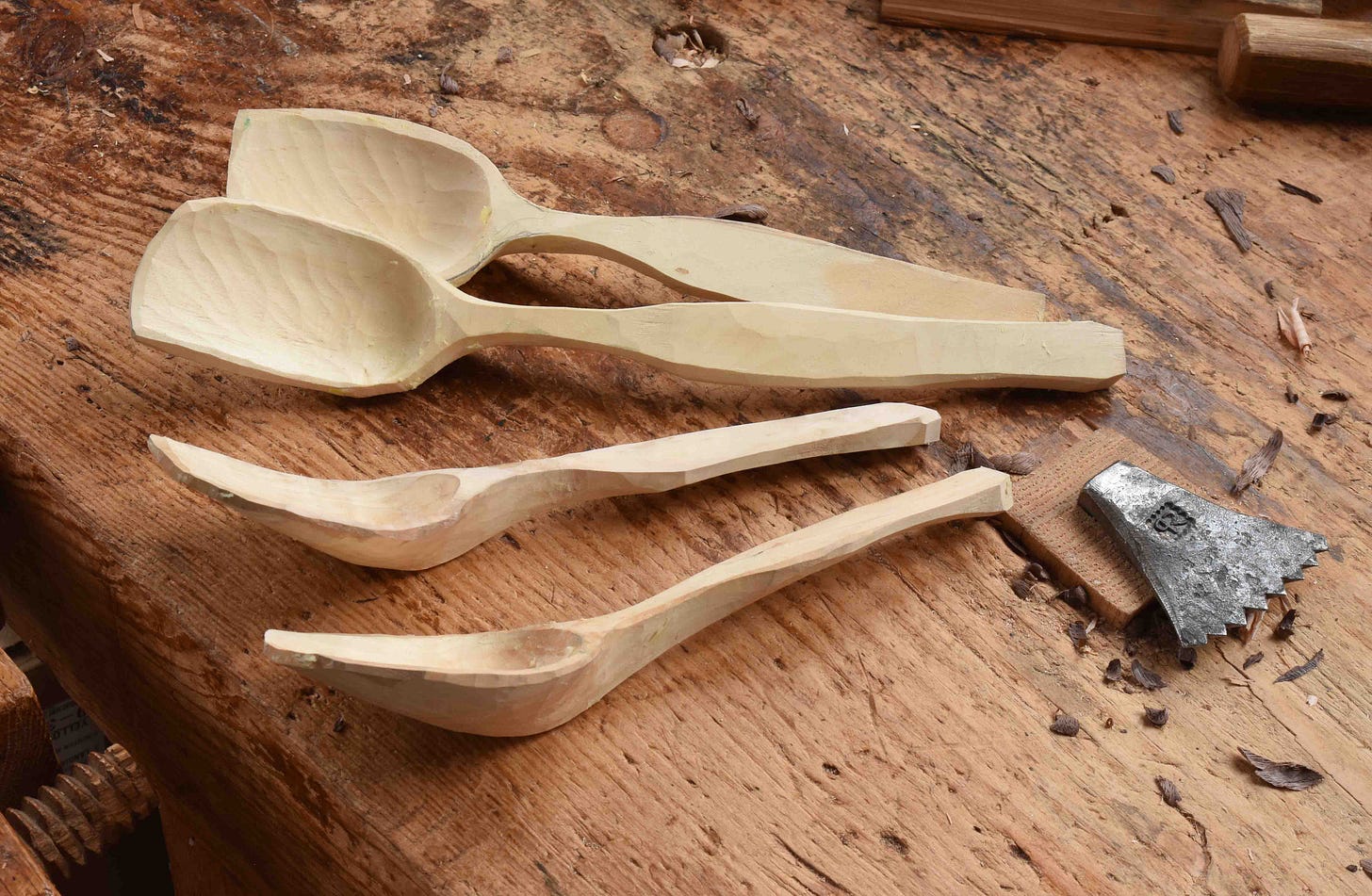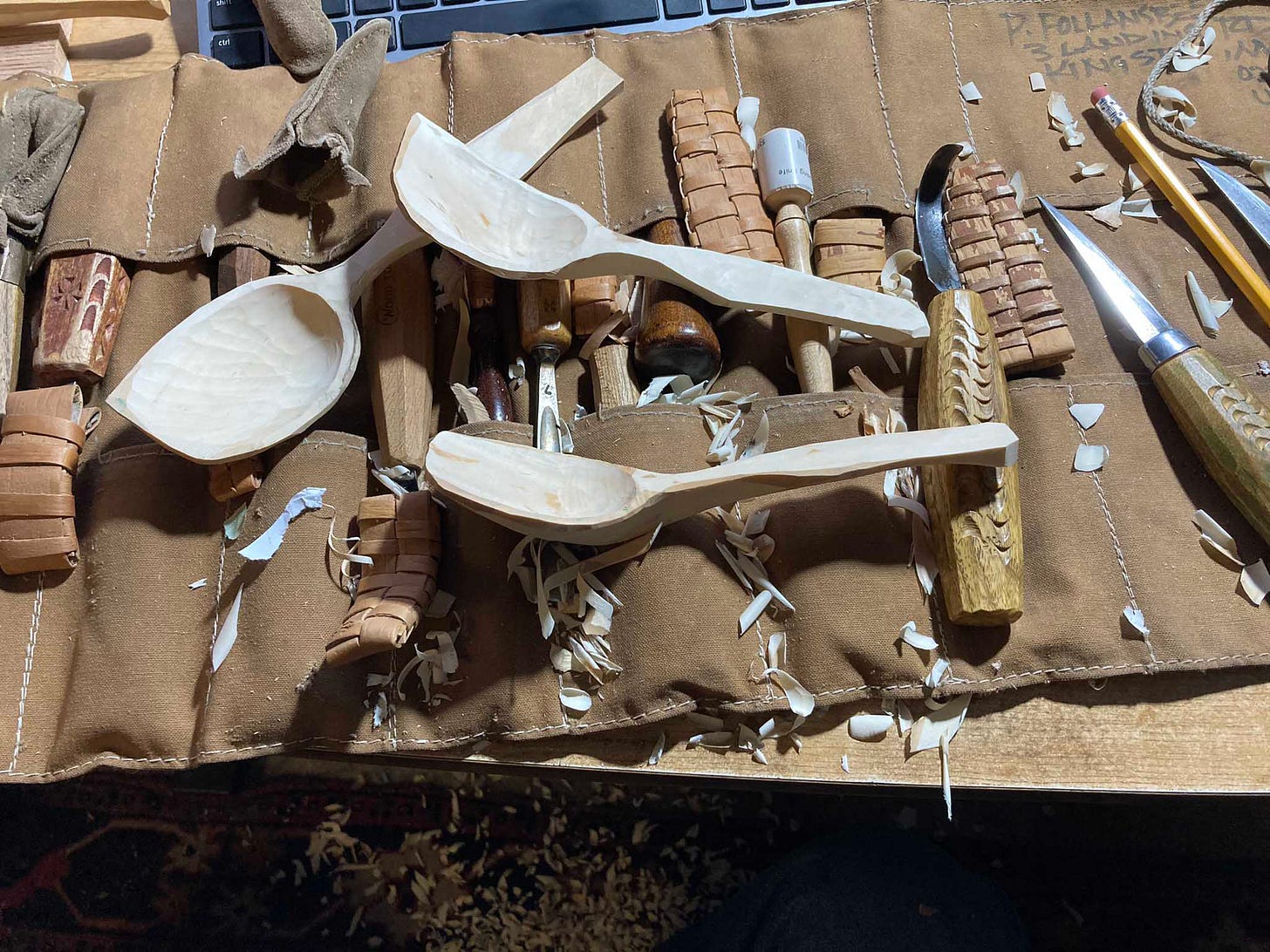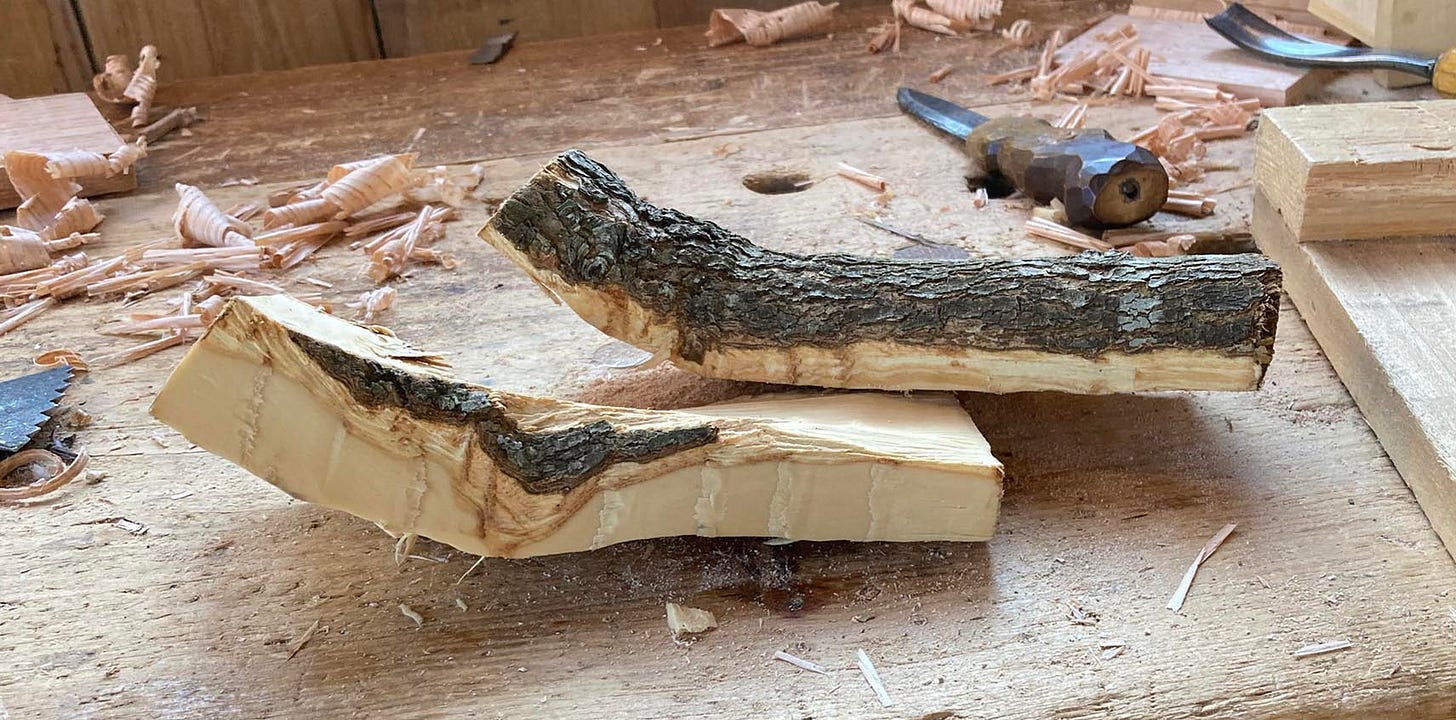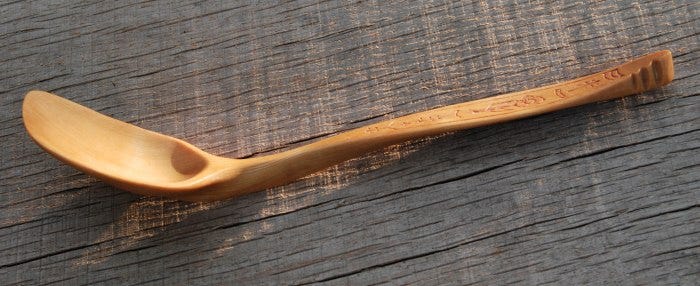[this week’s free post is something I wrote about 2017, on spoon carving. Just last week, I carved my first spoons in nearly 3 years. For one reason or another I had put them down and just lately picked them up again. Every year, there’s a few days when it’s too hot in my shop to work, and the reverse too - a few days each winter it’s too cold to bother. So I’ve been at my desk a bit lately, but was itching to make something - so got out my freshly-made spoons and went to work on them.]
Here’s the article -
In August 2016, I attended the 5th annual Spoonfest, the largest international gathering of spoon carvers, in Edale, Derbyshire, England. Over 200 people came from far and wide to spend 3-6 days totally engrossed in spoon carving. One question I had for them, and for all the spoon carvers I meet, is “why spoons, why now?”
Well, one of the first answers you get leads to what I call the First Universal Lie of Spoon Carving.
“You only need three tools” they say. (I’ve said it too.) A hatchet, a slöyd knife, and a hook knife for hollowing the bowl. Well, first off, you also need a saw for cutting the limbs, branches and other bits of raw material. So it’s four tools. But we always say three. And, the part that makes it a lie, every spoon carver I meet has more tools than they can keep track of. Long, short, deeply curved, shallow curves. Heavy hatchets, lighter ones. I am not immune. I find new tool-makers, and I think I’d like to try this knife, that hatchet. It goes on. So multiples of the basic tools, but then add the more specialized, maybe some hollowing adzes, if you can find a small one. How about the largest hook knives, the twca cam of Welsh spoon carving? What, it comes in two sizes?
Can’t forget decoration. Detail knives, chipcarving knives and more. So it’s easy to end up with a few dozen spoon carving tools. So let’s set aside the “you only need a few tools” bit.
One feature of spoon carving that is appealing is it’s just one piece of wood. No joinery, no fastenings, except for Jane Mickelborough’s folding spoons, but those are another story. Once you get going, you can make good progress in short time. You can pick it up and put it down in short bursts, and not really lose your place. Other than the hatchet work, you can do a lot of the work almost anywhere (well, not an airport, probably not a train) but you don’t need a dedicated workshop. I often carve spoons in the kitchen at night. I used to carve them in the playground while watching my children play. None of the moms would come near me, a grubby, weird old man with lots of knives...I wonder why.
I’ve been a furniture maker for a long time. One nice thing about spoon carving is that you can make another one right away. Try that with a chest of drawers, dining table, or what-have-you. Came close to the shape in your mind, but not quite there? Get the next billet of wood out and off you go. In fact, it’s pretty hard to stop spoon carving. You can carve a surprising number of spoons in spare time - and in doing so, you can do what my friend Jarrod Dahl calls “chase” the design - carve it again, and change one little thing, then again, then again. Small changes each time, improving on the idea. Spoons represent a design challenge that is at once simple and complex - the best spoons are lightweight, strong, and sleek. You learn about wood selection, grain direction, and structural, functional design. It doesn’t get old, I know of spoon carvers who have carved thousands of spoons. Think about potters, they often make so many multiples of an item. This is akin to that.
If you get the spoon-carving itch, you won’t look at trees the same way ever again. This can make driving dangerous, as lots of good spoon-shapes grow on the edges, near the sides of clearings like roads. I [sometimes] keep a short pruning saw under my seat in case I see something good by the side of the road. I don’t take stuff without permission though. The biggest challenge is to get there before the spoon carver’s nemesis - the wood chipper. For me, the best shapes are in the upper branches, and these often never really hit the ground when tree crews are working. But if you pull over, you might be able to talk them out of some of the good “crooks”, the bent connections between one limb and another. That’s where spoons grow.
To me, maybe one of the greatest explanation for “why now?” in spoon carving is the separation in modern society between people and natural materials and hand-work. We surely don’t need these hand-made wooden spoons - well, maybe we think we don’t need them. But maybe they are filling a void that our cultures have created. I live in an old house, have a hand-made shop out back. Am surrounded by hand-made wooden items, woolens, ceramics and other besides. When I visit a home that’s devoid of any human-made stuff - it feels funny to me. Now there’s lots of people who don’t see the world that way, and never miss the connection to nature and creativity...but there seems to be a growing number who are looking for just that.
I think one explanation for “why now?” with all this spoon carving is that people are finding a level of dissatisfaction in modern society, a disconnect between ourselves and nature. Spoon carving is an easy way to re-establish some of this connection. You can’t buy spoon wood at the store. It comes from trees. So before you know it, you’re learning about the trees around your area; what trees grow there? Are they native or introduced? Which trees succeed in which environments?
One more thing about spoon carving; a surprising discovery. It can be a social occasion - many woodworkers, whether professional or amateur, work in isolation. You can carve spoons (or any other small, knife-based carvings) in groups, and have a conversation while you do it. I’m a hand-tool furniture maker, but even so, I can rarely have visits in the shop while I’m working, my work can get loud, carving, planing, mortising - but spoon carving is (after the hewing) pretty quiet. I think of the knitters I know, and other textile crafts like hand-sewing - in fact my mother-in-law, seeing me get out spoon knives one evening, said “Oh, you’re getting out your knitting.”
[back to present-day - There’s too many spoon carvers for me to list them






This is such a pleasing read. Peter speaking of chasing, I've chased your story of taking spoons to the playground, or at outdoor practices and games on the weekend, and gotten away with no controversy. I think my kids think about knives and cutting tools in a good way as a result (probably more important is the creativity!). Thanks for the constant inspiration.
Peter, it is always a pleasure reading your notes. You are a craftsman with words as well as wood!